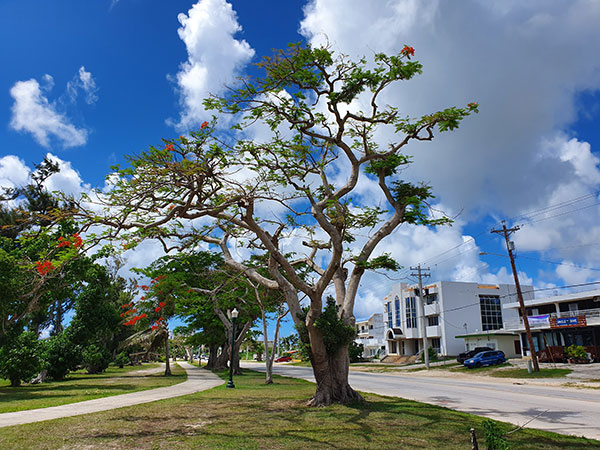No blooms in June
Yutu, other factors blamed for non-fiery flame trees
June is when flame trees are usually in full bloom, but July is just around the corner and hardly any flowers could be seen along Saipan’s main roads and thoroughfares this year.
CNMI Forestry’s Martin Pangelinan Jr. blames the near-absence of blooming flame trees on a combination of factors, chief of which is the trees’ lingering trauma from Super Typhoon Yutu.
“Not only did we lose the flame trees, we also lost a significant amount of native and non-native trees throughout the island,” Pangelinan added.
On top of that, a persistent drought from the dry El Niño weather phenomenon that has affected the Pacific since January still lingers, Pangelinan said, further preventing the flame trees from blooming.
Other causes of the delay are termites, invasive plants, and a fungus affecting the trees, he said.
CNMI Forestry discovered the termites inside some flame trees while checking out the trees for a research. Termites are attracted to decaying wood, and would feed on the insides of a tree.
The invasive vine called the ivy gourd (Coccinia grandis), sometimes called scarlet gourd, which grow alongside many flame trees, climb all over and overwhelms the tree by blocking it from sunlight and water, which stops or slows the growth of the tree.

A ficus plant has its branches encircling the trunk of a flame tree at the 13 Fishermen’s Monument on Beach Road. (MARC VENUS)
Pangelinan also pointed out that a ficus plant, locally called nunu, grows on the flame trees along Airport Road and is overwhelming the trees. If the ficus is still at a young stage, it can be removed easily by hand. However, once the ficus matures, the best solution is to remove the tree completely and replace it with a new one.
CNMI Forestry also reports that a fungus called phellinus noxius is attacking many trees and causing brown root rot. It attacks tree roots, causing them to decay, which cuts off water and nutrient supply to the crown, resulting in tree death.
According to Pangelinan, the best solutions for this situation would be to give the flame trees time to recover and to replace the trees that were destroyed, as it is a long-term process.
He believes that the trees will be back to normal by 2020.
CNMI Forestry is working with agencies such as the Marianas Visitors Authority and other partners to restore flame trees throughout the island and with the Micronesian Islands Nature Alliance on the “Bring Back Our Trees” campaign.
CNMI Forestry has a plant nursery where it is reproducing more flame trees and other trees to replace the ones that were destroyed by Yutu.























